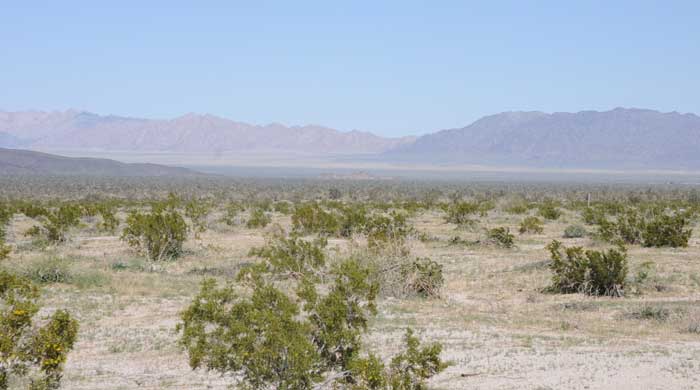
Chuckwalla Valley Solar Sprawl
UPDATES: March 17, 2010 - Site Visit
March 9, 2010 - First Solar Inc. and Pacific Gas & Electric Corp. made a long-term contract under which the San Francisco-based utility agreed to buy electricity from the 550-megawatt photovoltaic plant to be built in Riverside County. PG&E will take a 300 MW slice of the total capacity, with Southern California Edison already signed on for the remaining 250 MW.
January 13, 2010 - Desert Center, Riverside County.
A Notice of Intent to prepare an Environmental Impact Statement for a new thin-film cadmium-telluride photovoltaic project was issued by Bureau of Land Management (from BLM Palm Springs website). The utility-scale solar project would partially surround private properties and is next to the town of Desert Center. Download the Plan of Development (large file, 129 MB pdf).
First Solar Inc., has requested a right-of-way (ROW) authorization to develop a 550 megawatt project on 4,410 acres. The PV generating facility and most of the corridor for the project’s 230-kilovolt (kV) generation interconnection (gen-tie) transmission line would be located on BLM-administered lands. A survey contractor had trespassed on private land in 2009 >>here. They were later fired.
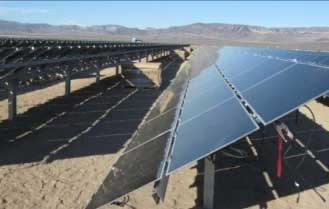 The proposed project will include the solar farm, an on-site substation, the 230 kV gen-tie line within the transmission corridor, and a planned 230- to 500-kV Red Bluff substation. The Red Bluff substation will connect the project to the Southern California Edison (SCE) regional transmission grid. Should the project be approved, the interconnection transmission line would be about 9 miles to about 13 miles long, depending on the alternative selected.
The proposed project will include the solar farm, an on-site substation, the 230 kV gen-tie line within the transmission corridor, and a planned 230- to 500-kV Red Bluff substation. The Red Bluff substation will connect the project to the Southern California Edison (SCE) regional transmission grid. Should the project be approved, the interconnection transmission line would be about 9 miles to about 13 miles long, depending on the alternative selected.
If approved, construction would begin in late 2010 and would take approximately 41
months to complete. There is some concern, however, about how carcinogenic cadmium could be released if the panels are sand-blasted and degrade.
An amendment to the California Desert Conservation Area Plan would have to be done.
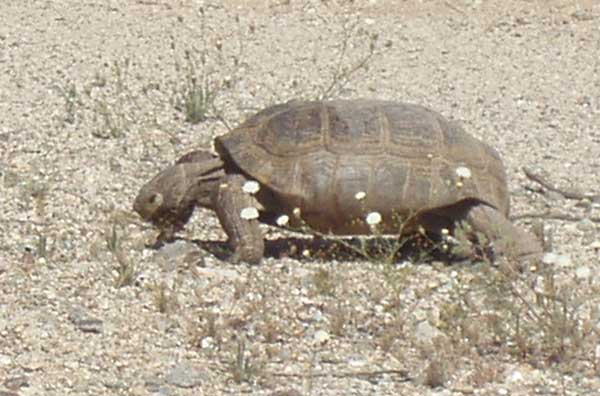
^Desert tortoise on the proposed site. Several tortoises were found on the site by First Solar biologists. (Photo by Donna and Larry Charpied)
Federally Threatened Desert tortoises are common here, and the project is near the Chuckwalla Desert Wildlife Management Area (DWMA), critical habitat for the tortoise. Burro deer are found here as well.
The Palm Springs Round-tailed ground squirrel (Spermophilus tereticaudus var. chlorus), a Federal candidate species, lives in the region. It is a California Department of Fish and Game Species of Special Concern. It prefers sand dunes and mesquite hummocks.
Burrowing owls and Golden eagles also inhabit the site.
A Federally Endangered plant, Coachella Valley Milkvetch (Astragalus lentiginosus var. coachellae), may be present. It was found on the ROW. This flower occurs in coarse sands of washes, dunes, sand flats, and sand deposits in creosote scrub. The primary threat to the Coachella Valley milkvetch is habitat destruction due to development, as well as sand stabilization from blocking of sand flows.
Why Not Distributed Generation Instead?
Engineer Bill Powers recently pointed out (in testimony given to the California Energy Commission in January 2010) that nothing prevents a utility-scale photovoltaic project from going on rooftops, such as spread out over large commercial buildings -- the connections are the same.
There is essentially no economy of scale with PV. That is, rooftop thin film and wilderness thin film will cost the same and perform the same. Southern California Edison would have a viable alternative because the rooftops in their service area receive very close to the same insolation as Desert Center, and any difference would be accounted for in transmission losses. Since rooftop solar owned by us would be FREE to the utility, and since there is enough rooftop to make the region a NET EXPORTER of solar power, there is no economic or feasibility argument other than speculative profits, which is not a compelling reason to destroy wilderness. All they need to do is to enter into purchase agreements that adequately compensate ratepayer generators and they can easily hit their RPS with no infrastructure and a lower increase in prices than they will charge for the remote power plant solar power.
Comments Needed
Comments on issues may be submitted in writing until Friday, February 12, 2010. A public scoping meeting will be held on January 28 from 5:00 p.m. to 9:00 p.m. at the University of California Riverside – Palm Springs Campus in the Heckman Building located at 75-0800 Frank Sinatra Drive, Palm Desert, CA 92211. We have asked for more scoping meetings.
Comments on issues and planning criteria related to the First Solar Desert Sunlight Solar Farm Draft EIS/PA may be submitted by any of the following methods:
1) Website: http://www.blm.gov/ca/st/en/fo/palmsprings.html
2) Email: CAPSSolarFirstSolarDesertSunlight@blm.gov
3) Fax: (760) 833-7199
4) Mail: Allison Shaffer, Project Manager, Palm Springs South Coast Field Office, BLM, 1201 Bird Center Drive, Palm Springs, CA 92262. For information contact Allison Shaffer, BLM project lead at (760) 833-7100.
Palm Springs South Coast Office of Bureau of Land Management
Also:
Greg Miller
Program Manager
Renewable Energy Coordinating Office
California Desert District
Bureau of Land Management
22835 Calle San Juan de Los Lagos
Moreno Valley, CA 92553
Ph 951 697-5216
Cell 951 970-8859
February 5, 2010 - These are our concerns about this project:
Project: The preferred project site contains 4,410 acres of undeveloped land. The Right of Way is substantially larger. Does First Solar have plans to expand their project? If there is potential to use a larger acreage, that the EIS should address cumulative issues that would occur on all acreage instead of only focusing on the 4,410 acres.
Deadline for this Project: Due to the outstanding unresolved issues that this project has instigated, we would like to request that the scoping deadline be extended into the beginning of April.
Fast Tracking Deadlines: We believe it is unwise for the BLM to be using “fast tracking” seemingly to expedite approval of this project. We feel that there are enough outstanding unresolved issues that make approval and construction of facilities by November of 2010 a very unrealistic goal. We would like to request that this project be removed from the fast track list in order to provide us with more time to examine the issues. We think a more realistic goal for the EIS process should extend into the year 2012, so more comprehensive biological and cultural site surveys can be conducted.
Alternatives: We support the No Action Alternative, but we request at least one viable third alternative away from the site be provided in the EIS.
Purpose and Need: Although it is not the job of the BLM to list private land alternatives, there is little logic found in the purpose and need for the project. Many renewable project developers have failed to consider reasonable or viable alternatives that could serve as solutions that everybody could live with. In the case of this particular project, conflicts with private property owners, cultural resources, storm water drainage erosion, endangered species, viewscapes from National Parks and wilderness areas could all be avoided with a distributed generation alternative. Thin film photovoltaic can be sited on developed areas using rooftops, parking lots and other urban vacant lots. The beauty of this is that there is essentially the same insolation in Riverside, Orange County and Los Angeles as there is in the region of Desert Center, and any difference would be accounted for in ten percent transmission losses through the long journey through power lines, anyway.
Ratepayers will be paying increased costs for electricity because of the need for upgraded and new transmission lines from remote desert locations, In addition, taxpayers will be subsidizing the project with DOE loan guarantees and ARRA grants, with little return in efficient power generation. Instead, the state’s Renewable Portfolio Standard goal can easily be reached by point-of-use options in load centers, with lower or no increase in prices than for the remote power plant solar power. This option would eliminate the need to degrade so much public land, preserve the natural and cultural integrity of the region, and preserve the multiple use philosophy of the BLM by not giving away so much public lands to only energy companies. Therefore there is no need for this project.
We would like to request that distributed generation be discussed as a viable solution to these conflicts in the purpose and need section of the EIS document.
Output of energy: The nameplate capacity of the project is 550 MW. But the capacity factor for thin-film is 28-30%, so the output of energy would be small, and not outweigh the degradation and fragmentation of healthy functioning habitat and species. Additional loss from long transmission lines makes any benefits of the project to greenhouse gas reduction too small compared to loss of habitat and multiple use for recreationists.
Local jobs: Solar technology is specialized. Most energy developers make promises to local communities that there will be hiring of local people, yet many energy developers usually bring people in temporarily and little benefit is provided to the local economy. Furthermore, when developers use only federal land, local economies receive fewer tax benefits. This is why a private land alternative should be considered.
Socio-economics: Turning the area into an industrial park is not consistent with a local tourism based economy. Joshua Tree National Park has outstanding benefits to local economies in surrounding communities because its outstanding scenery attracts millions of visitors each year. Those visitors come to view nature and sweeping views. The cumulative impacts of surrounding this irreplaceable treasure with renewable energy facilities has the potential to drive tourism dollars away. We would like to request that BLM provide a full analysis on the potential impacts that reorganizing publicly supported desert protection measures would have on local tourism economies. Furthermore, tourism has stood the test of time. The new renewable economy that the Obama Administration is forcing upon us has not been tested for long-term economic sustainability. Because so much federal money is needed up front to make this experimental green economy work, we are worried that its potential failure will destroy the already stable tourist economy of the region.
Access and Recreation: The project area is located mostly on public lands. Will the project site be designed to have access corridors going through it? What kind of “mitigation” would be provided to compensate for disruption of access? Has this been considered?
Greenhouse gases: The applicant’s Plan of Development has indicated a need for transmission line upgrades and new transmission facilities. The green house gas called SF6 is used primarily in electricity transmission - and is emitted in especially large amounts in construction of new lines – and is 24,000 times as potent as CO2 in it’s global warming impacts. The Environmental Protection Agency has declared “that the electric power industry uses roughly 80% of all SF6 produced worldwide“. Ideally, none of this gas would be emitted into the atmosphere. In reality significant leaks occur from aging equipment, and gas losses occur during equipment maintenance and servicing. With a global warming potential 23,900 times greater than CO2 and an atmospheric life of 3,200, one pound of SF6 has the same global warming impact of 11 tons of CO2. In 2002, U.S. SF6 emissions from the electric power industry were estimated to be 14.9 Tg CO2 Eq. (http://www.epa.gov/electricpower-sf6/basic.html).
Please provide a detailed analysis of the amount of SF6 gases that would be released by this project.
Carbon sink: Scientific studies have revealed that desert vegetation and biological soil crusts in the ecosystems, as well as soils, have the ability to store C02 gases (Have Desert Researchers Discovered a Hidden Loop in the Carbon Cycle? Richard Stone: Science 13 June 2008: Vol. 320. no. 5882, pp. 1409 - 1410 DOI: 10.1126/science.320.5882.1409).
How much C02 storage capability would be replaced by development? If the goal is indeed to reduce greenhouse gases, is it wise to remove this much carbon storing living crust? Please provide a detailed analysis on the amount of GHG that would otherwise be offset by an intact arid ecosystem.
Air Quality: What long-term effects will removing 4,000 acres of topsoil have on the air quality of the region? Erosion from clearing is likely to substantially increase the amount of particulate matter that will be airborne during strong wind events. How much water will be used to control dust during construction? Over-runs of estimated water use because of excessive dust is a potential problem.
Weed Removal and Control: What herbicides would be used to remove vegetation from under the solar panels? How will these toxins be prevented from getting into the ground and groundwater? What effects, short-term and long-term would the use of these chemicals have on public health? Will local landowners be at risk? How will these herbicides affect sensitive wildlife and plants? Hundreds of miles of small roads will be constructed. That has the potential to create a serious weed problem in the area. Invasive plants pose a serious threat to both ecosystem functioning and desert tortoise population viability.
Vegetation Removal: How will vegetation be removed? Will it be bladed by large scrapers? How will vegetation be kept off of the site? Will any vegetation be left growing near the panels?
Water: Exactly how much water will be needed to build this project?
Please give an accurate number of acre-feet. Where will this water come
from? Will the use of all this water draw down the aquifer?
How much water will be needed to wash off the panels? Solar developers
consistently give inaccurate accounts of the amount of washing that will be
necessary. Blowing dust requires the concentrated thermal unit at Kramer
Junction to wash their mirrors every week. Please list the amount of
acre-feet for panel washing. Will water softeners be used to prevent spotting?
What chemicals are in the softeners? Will they be hazardous to public health and
wildlife? Will they compact soils?
Storm Water Drainage: Several washes come down from Eagle Mountain and
Converge in the project area. These can flash-flood during both summer
thunderstorms and winter storm events, especially during El Nino years. How
does the applicant propose to prevent damage to the panel field? Will berms and
drainage channels be constructed? Will these be inside or outside the ROW?
How much desert will be impacted? Will security fences block any flow that
carries debris such as rock and branches? Please give a detailed description of
acreage of flood-control structures and engineering plans and maps. How will
flood damage affect the operation costs of the plant?
If flood detention basins are constructed, how long will water be kept in the
basins, and will bird-netting be placed over the ponds to prevent bird deaths?
Are federal and state jurisdictional waters on the project site? We believe some
may be present. Washes are important wildlife and plant habitat. What form of
mitigation will the applicant undertake to replace functioning waterways off site?
Thin Film Solar and Cadmium: There are several references that have raised
issues of concern with cadmium telluride primarily due to the risk of broken
equipment releasing this heavy metal:
http://earth2tech.com/2008/09/25/cadmium-the-dark-side-of-thin-film/
Our concern is that nobody has really attempted to think about this. If the panels
do degrade or erode from potential damage such as storm water flooding or
sand abrasion over the next decade, will cadmium be released and if so, how
would that effect public health, water quality and wildlife resources? Sand
abrasion is an unresolved issue and will need special attention in the EIS. To
place 4,000 acres of these panels in an undeveloped area like this is
unprecedented. We would like to request that the issue be fully examined in the
EIS.
(We are much less concerned about thin-film used on urban and rural rooftops in a distributed generation alternative, where the panels are not at ground level subject to blowing sediments.)
Visual Resources: Key Observation Point locations should be set up from 3
sites in Joshua Tree National Park and at least two in the Chuckwalla
Wilderness. A cumulative analysis should be made concerning how the several
renewable energy projects proposed for the region of the I-10 corridor would
impact the overall scenery, impact the quality of life of local residents and their
property values, and impact the local tourism economy by creating a much less
scenic view as well as turning the character of the area into an industrial look.
How would the site be lighted at night time? How visible would this lighting be from
Joshua Tree National Park, the Chuckwalla Wilderness Area and adjacent
private property? What measures would be taken to minimize security lighting at
night?
CDCA Plan Amendment: An amendment to the California Desert
Conservation Area Plan of this size should undergo its own extensive
environmental review.
Adjacent Private Property: The BLM should examine how siting of large energy
projects would impact private property values and quality of life for local
communities. There are properties in the region and land owners stand to lose
quite a bit if BLM approves this project. We would like to request an analysis of
the projects impacts to adjacent property owners, property values, and quality of
life be addressed in the EIS. First Solar created problems for local land owners
by illegally driving on their property and leaving garbage and survey stakes on
the property. Although BLM resolved this particular issue, this could be very
indicative of First Solar behavior and their reputation as law abiding neighbors.
How many more problems like this will arise?
Cultural Resources: The following quote comes from the applicant’s cultural survey report in the POD:
“Given the sparse cultural resource survey coverage of the Project Study Area to date, Mr. Dalu recommends 100 percent (Class III) survey of the Preferred Project Site (i.e., the boundaries of ground disturbance or ‘project footprint’) in order to meet the requirements of Section 106 of the National Historic Preservation Act. Mr. Dalu also recommends the participation of a geoarchaeologist in the Class III study, including characterization of subsurface sediments in the Preferred Solar Farm Site to assess the potential of those sediments to contain subsurface archaeological materials. First Solar intends to conduct a Class III 100 percent survey of the Preferred Project Site, with the participation of a geoarchaeologist.”
First Solar has been planning to develop and completely blade this site for close to three years now. It seems unusual that First Solar has neglected to gather this information until the 11th hour of the NEPA process. The deadline of the EIS will need to be extended at least two years in order for the applicant to give us a detailed description of what cultural sites are actually out there.
What will happen to cultural sites found on the site? Will they be collected and archived or simply destroyed? We request that First Solar be required to document, avoid what is possible, and archive all cultural resources into a museum.
Are there any burial sites on the project site? Will First Solar simply be given permission to destroy these resources?
Native American Tribal Concerns: The POD states that all Native American Tribal concerns and information were requested from the Native American Heritage Commission (NAHC) in Sacramento. What are the concerns of local tribes? Why didn’t First Solar even bother to talk to the people to address their concerns? If they have been planning this project for close to three years, there is really no excuse why this has been neglected. We would like a detailed description of all local Native American Tribal concerns written in the EIS.
The proposed project site lies within the homeland of the Chemehuevi. While the POD states that cultural sites are insignificant on the project site, we are requesting that BLM organize a site visit with elders of the Chemehuevi Tribe. We would also like to request that BLM consider having First Solar submit a new plan that adequately avoids significant cultural resource sites. The Chemehuevi have expressed concern to BLM over the Ivanpah Solar Electric Generating System. While BLM has claimed that they sent all the relevant information to The Chemehuevi, the Chemehuevi are displeased because they have not been consulted on that particular project. That is not acceptable. An open line of communication will have to be maintained with the tribes who hold a special interest on this land.
The Chuckwalla Valley project area has other tribes that have a cultural history in the area as well. BLM and the applicant should contact them as well and organize site visits.
Biological Resources: These are sensitive species that need consideration.
A. Desert Tortoise (Gopherus agassizii):
Resumes: We would like to request to view the resumes of the biologists who conducted the tortoise surveys.
Survey methodology: From the POD: “Desert tortoise sign was found throughout the surveyed portion of the PSA, Forty live tortoises were observed throughout the surveyed portion of the PSA. Based on current estimates of the number of tortoises typically found during this type of survey, an estimated 55 to 85 desert tortoises are likely to inhabit the surveyed portion of the PSA. Figure 9 shows areas where carcasses were observed during these surveys. These carcass locations appear to be consistent with areas of current desert tortoise populations within the PSA.”
Please describe the methodology the applicants used to conclude the 55 to 85 number of tortoises on the ROW. We believe that more surveys will need to be conducted to get a more accurate estimate. We would like to request surveys be conducted yearly to the fall of 2012.
What type of survey methods were used to declare only 20 or 30 tortoises are on the preferred project site? Any biologist will tell you that an estimate like this holds little weight. It could very well be that there are three times that many. How many surveys were conducted? Were they reconnaissance surveys? Was this number only determined by presence/absence surveys? We would like to caution the BLM against accepting these as the final numbers. Additional surveys will be needed for a more accurate estimate.
Health status: What is the health status of this population? Were any symptoms of Upper Respiratory Tract Disease detected? If so, was this just a visual survey? Will desert tortoise be given the ELISA blood test before they are translocated? We would like to request that the applicant be required to conduct blood work on all tortoise to be translocated.
Cutaneous dyskeratosis is a shell disease that has unknown implications on desert tortoise populations. In advanced cases, exposed areas become infected with bacteria, fungus, and exposed tissue and bone may become necrotic. Cutaneous dyskeratosis was initially identified on the Chuckwalla Bench Desert Wildlife Management Area, Riverside County, California, USA. Hypotheses for the cause of the disease include auto-immune diseases, exposure to toxic chemicals (possibly from mines, or air pollution), or a deficiency disease (possibly resulting from tortoises consuming low-quality invasive plant species instead of high-nutrient native plants). We are concerned that destructive events such as flash flooding will release cadmium into the ecosystem, thus having the potential to intensify this problem. We would like to request a study on the impacts of heavy metals and other toxins potentially released by the proposed project would have on desert tortoise populations relating to the disease cutaneous dyskeratosis.
Habitat Quality and Connectivity: The applicant dismisses the project site as a category three habitat and claims that ”the project site is not essential to maintenance of viable populations, that contain low to medium densities, and that are not contiguous with medium or high density areas and in which the population is stable or decreasing”.
We would like to remind BLM and the applicant that protection of the tortoise does extend outside of just critical habitat or DWMA’s. The project site is located in a topographically favorable region between the Chuckwalla DWMA and the Joshua Tree DWMA. This region of the project site is important to maintain as undeveloped because it provides connectivity between two recovery units of the desert tortoise. A recent study by Dr. Cameron Barrows suggested that habitat connectivity be maintained between Joshua Tree National Park and surrounding populations to insure that tortoises can adapt to changing environmental conditions such as climate change.
(Niche Modeling and Implications on Climate Change on Desert Tortoise and Other Reptiles in Joshua Tree National Park. Cameron Barrows September 28th, 2009.)
Mitigation: What mitigation measures will be taken? BLM requires a one to one mitigation and CEQA requires a 3 to one mitigation. We request that the applicant be required to buy 12,000 acres of private land of desert tortoise habitat. This habitat should be in the same genetic recovery area as the project site. For example, it would not be appropriate to purchase land in the West Mojave Recovery Unit to offset this project. Mitigation land should also include connectivity corridors between recover units as is the proposed project site.
Mitigation land for desert tortoise should not overlap with different species of rare plants, burrowing owls and other sensitive species. Other species often have different ecological requirements so it is important not to undermine their needs by lumping all species needs to one category.
Translocation site: Where will desert tortoise be translocated to? Has a translocation site been selected yet? How far away from the project site will it be? Are there other tortoises on the site? What is the health status of the tortoises on both sites? The translocation site will need to be in the same genetic recovery unit as the project site.
Predator Control: Would the facilities and the development around them attract predators such as ravens and coyotes? How would these disturbances be minimized? Will predators be shot, poisoned or killed in any way? Please describe in detail, what predator control measures would be taken.
Chuckwalla Critical Habitat: The project will traverse 192 acres of the Chuckwalla Desert Wildlife Management Area (DWMA), Critical Habitat for the Desert Tortoise. The applicant boldly suggests that the one percent development rule for energy companies on DWMA’s should be applied to their project. Are there other applicants who are proposing to develop one percent of this DWMA? If so, which ones? Is it wise to give First Solar a priority to this land? If First Solar is allowed to destroy 192 acres of this DWMA, we would like to suggest a 5 to one mitigation for this 192 acres. This should go on top of the three to one mitigation that should be applied to the 4,000 acres outside of the DWMA.
B. Burrowing Owl (Athene cunicularia): All burrowing owls should be passively removed and not actively removed or excavated from their burrow. (Passive meaning wait for the owl to come out). Avoidance of owls and restructuring of the project site may be necessary. California Department of Fish and Game protocols (Burrowing Owl Survey Protocol and Mitigation Guidelines. 1993. Prepared by the California Burrowing Owl Consortium. www.dfg.ca.gov/wildlife/nongame/docs/boconsortium.pdf, accessed November 10, 2009) will need to be implemented. The guidelines recommend that for off-site mitigation, replacement of occupied habitat with 9.75 acres of occupied habitat per pair or single owl found, or 13 acres of contiguous habitat per pair or single bird, or 19.5 acres of unoccupied habitat per pair or single bird.
C. Foxtail Cactus: (Coryphantha alversonii): A federal Category 2 candidate (information is currently being collected to see if the species should be listed as threatened or endangered) and a California Native Plant Society (“CNPS”) 1B species (plants rare, or endangered in California and elsewhere). Three populations of foxtail cactus were observed during Project Study Area surveys, but less than one percent of the plants are inside the Preferred Project Site boundary.
What will happen to the plants on the site? Will they be relocated or destroyed? What mitigation land is available that has a good population of this species on it?
D. California Barrel Cactus: (Ferocactus cylindraceus): Will cacti be counted, then relocated? To where? We strongly suggest no cacti be sold.
E. Coachella Valley milk-vetch (Astragalus lentiginosus var. coachellae) FEDERALLY ENDANGERED. The biological report states that one individual plant was found 2.5 miles from the project site. How extensively was this species surveyed for? An annual plant’s distribution depends on its delicate balance of seed dispersal and open corridors for pollinators. What is the potential for this species to occur on more of the 4,000 acres? What mitigation requirements are listed in this species Recovery Plan? This plant is critically endangered in the Coachella Valley to the west. It may be important to give careful consideration to preserving “fringe” populations of species whose core populations are seeing rapid demise. This could very well be habitat for a fringe population and differing rainfall years may determine different perspectives on abundance. More consideration is needed before BLM simply writes this occurrence off as insignificant. Multiple years of surveys will be needed to determine presence and density.
F. Common Chuckwalla (Sauromalus ater)
G. Northern Harrier (Circus cyaneus)
H. Sharp-Shinned Hawk (Accipiter striatus)
I. Cooper’s Hawk (Accipiter cooperii)
J. Golden Eagle (Aquila chrysaetos) How much foraging habitat for this species be removed by the project?
K. Peregrine Falcon (Falco peregrinus)
L. Black-Tailed Gnat Catcher (Polioptila melanura) How will the project affect breeding and foraging habitat for this species?
M. LeConte’s Thrasher (Toxostoma lecontei) How will the project affect breeding and foraging habitat for this species?
N. Loggerhead Shrike (Lanius ludovicianus)
O. Yellow Warbler (Dendroica petechia) How will removal of migration habitat, i.e. arboreal wash species, affect this migrant?
P. Yellow-Breasted Chat (Icteria virens)
Q. California Leaf-Nosed Bat (Macrotus californicus)
R. Townsend’s Big-Eared Bat (Plecotus townsendi)
S. California Mastiff Bat (Eumops perotis)
T. Pallid Bat (Antrozous pallidus)
U. American Badger (Taxidea taxus)
V. Yuma Mountain Lion (Puma concolor browni)
W. Burro Deer: (Odocoileus hemionus eremicus) How will the construction of panels and the removal of arboreal wash habitat impact the connectivity of this species?
X. Nelson’s Bighorn Sheep (Ovis canadensis nelsoni) There is a potential that bighorn sheep will use this site for winter foraging. How would development of the alluvial fan and desert floor impact potental desert bighorn winter forage habitat? Bighorn will often cross alluvial fans and desert floors. How would construction of such a large facility impact connectivity of bighorn sheep populations and migration corridors?
Sensitive Species: The POD states that 31 sensitive species occur in the project area and 17 occur on the preferred project site. Mitigation for these species should meet their individual needs over an attempt to lump all their habitat needs together. Overlapping habitat needs should be examined individually. Corners should not be cut by making a general plan for all 31 species. Rather, individual mitigation plans involving separate acreage to purchase should be implemented for the strictest habitat and species protection.
Living Soil Crusts: Biological soil crusts are formed by living organisms and their by-products, creating a surface crust of soil particles bound together by organic materials. Crusts are predominantly composed of cyanobacteria , green and brown algae, mosses, and lichens. Liverworts, fungi, and bacteria can also be important components.
Crusts contribute to a number of functions in the environment. Because they are concentrated in the top 1 to 4 mm of soil, they primarily affect processes that occur at the land surface or soil-air interface. These include soil stability and erosion, atmospheric nitrogen fixation, nutrient contributions to plants, soil-plant-water relations, infiltration, seedling germination, C02 offsets and plant growth. Crust-forming cyanobacteria have filamentous growth forms that bind soil particles. These filaments exude sticky polysaccharide sheaths around their cells that aid in soil aggregation by cementing particles together. Fungi, both free-living and as a part of lichens, contribute to soil stability by binding soil particles with hyphae. Lichens and mosses assist in soil stability by binding particles with rhizines/rhizoids, increasing resistance to wind and water action. The increased surface topography of some crusts, along with increased aggregate stability, further improves resistance to wind and water erosion. Crusts can alter water infiltration. Studies where crusts greatly increase surface roughness generally have increased infiltration with the presence of crusts. Where crusts do not significantly increase surface roughness, infiltration is generally reduced due to the presence of cyanobacterial filaments. Differences in findings are therefore site specific and also related to soil texture and chemical properties of the soil.
Living soil crusts also store C02 and their removal may contribute to a lack of organic offsets anthropogenic greenhouse gas emissions. It would be a wise idea for BLM to calculate the amount of C02 that the removal of 4,000 acres of soil crust and vegetation would offset.
Conclusion: While the use of solar energy can be a clean technology, it is not environmentally responsible unless it is sited properly. Because solar energy requires so much space to produce the desired amount of energy from any given project, it will have a massive footprint if it is placed on relatively undisturbed land. Fortunately, that space on disturbed land is available in the state of California and there are plenty of places that this technology should be used on. Urban centers in Southern California have large mounts of unused roof tops, parking lots, billboards, degraded urban lots, etc., etc, that have not been utilized yet for this technology. The BLM lands in the area of the project site are preserved for multiple use activities, but giving away so much land for energy development only conforms to one user group, energy developers. There are alternatives to this kind of “energy sprawl”. For many reasons, we support the No Action Alternative.
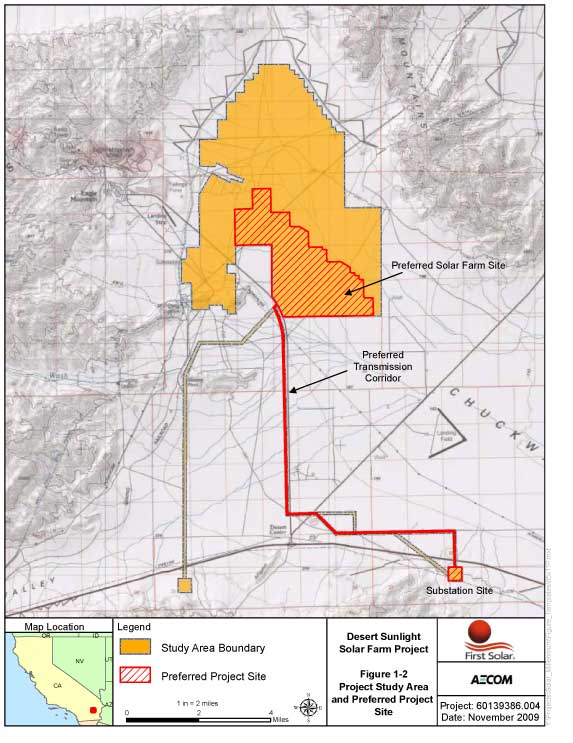
^Map of proposal (from POD). The Right-of-Way and much of the project would surround a private farm.
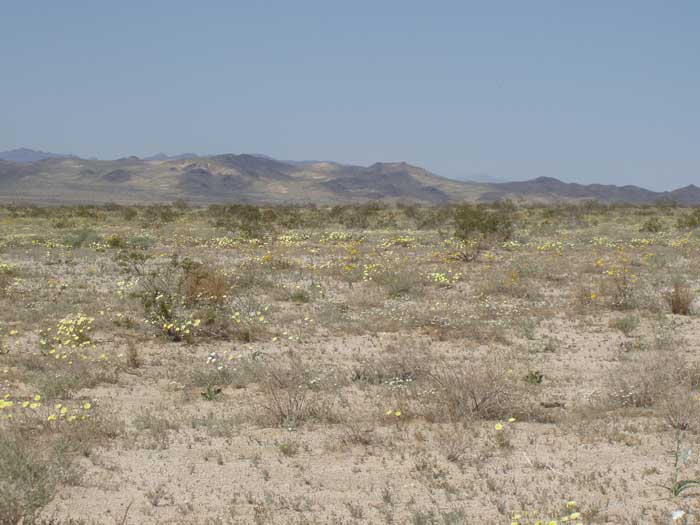
^Proposed site of First Solar development, wildflower-laden Chuckwalla Valley in the Colorado Desert. (Photo by Donna and Larry Charpied)
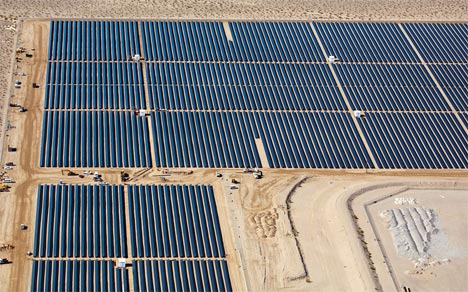
^First Solar constructed this photovoltaic array that Sempra purchased, in the Boulder City Green Zone, southern Nevada. This would be similar to the Desert Sunlight project.
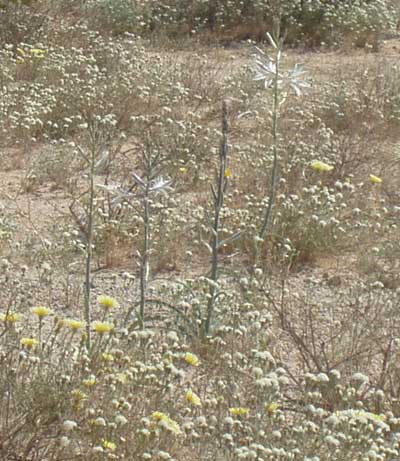
^Desert lilies, pincushion flowers, and Desert dandelion, on the site in spring 2005. (Photo by Donna and Larry Charpied)
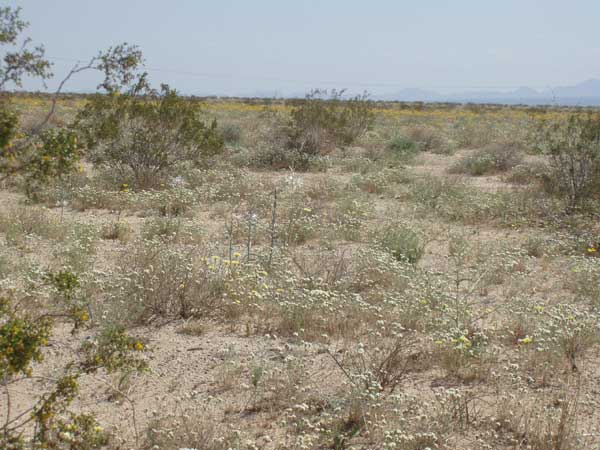
^Creosote and Wildflowers on the site. (Photo by Donna and Larry Charpied)
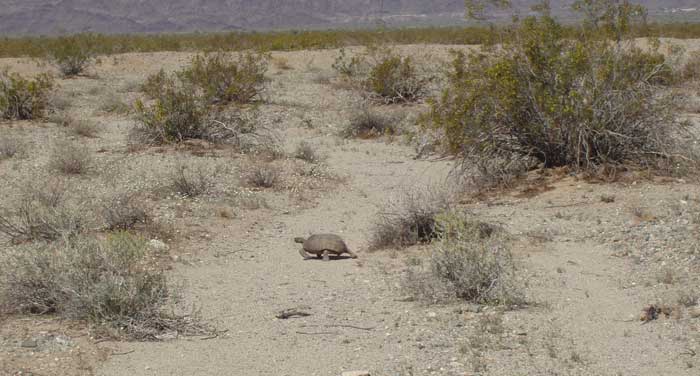
^The project site is tortoise habitat. (Photo by Donna and Larry Charpied)
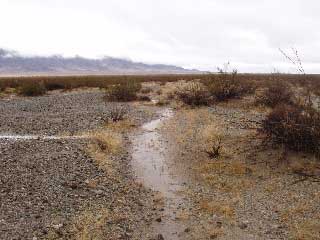
^Winter rain from an El Nino event at the site. (Photo by Donna and Larry Charpied)
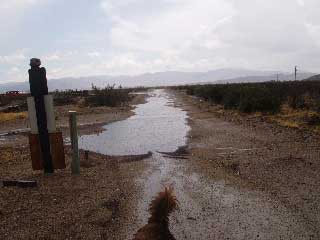
A rainstorm in winter on a road. people live here and panels will go right up to property boundaries. (Photo by Donna and Larry Charpied)

^Beautiful Chuckwalla tortoise habitat. (Photo by Donna and Larry Charpied)
